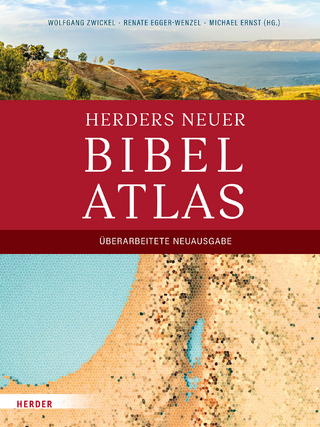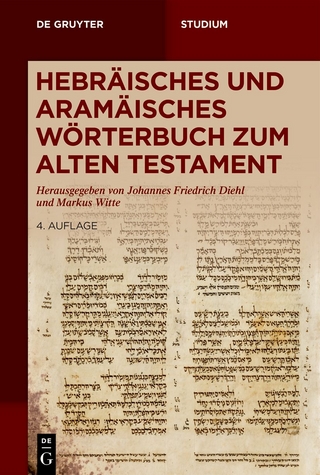
Typology-Understanding the Bible's Promise-Shaped Patterns
Zondervan Academic (Verlag)
978-0-310-53440-2 (ISBN)
Read the Bible with Fresh Eyes as You See Scripture's Promise-Shaped Patterns
When you read the Bible, have you ever noticed parallels between certain people, events, and institutions? Should we understand Noah as a kind of new Adam, and if so, does that somehow point us to the second Adam? How are we to interpret these similarities?
In Typology--Understanding the Bible's Promise-Shaped Patterns, author James M. Hamilton Jr. shows that the similarities we find in the Bible are based on genuine historical correspondence and demonstrates how we recognize them in the repetition of words and phrases, the parallels between patterns of events, and key thematic equivalences. When read in light of God's promises, these historical correspondences spotlight further repetitions that snowball on one another to build escalating significance.
This book stimulates fresh thinking on the relationship between the Old and New Testaments and will help pastors, preachers, and students better understand the dynamics of inner-biblical interpretation. It explores several of the "promise-shaped patterns" we see in the Old Testament including:
Adam and New Adam
Prophets, Priests, and Kings
The Righteous Sufferer
Creation
Exodus and New Exodus
Marriage
Hamilton shows that the prophets and sages of Israel learned to interpret Scripture from Moses and his writings. And by tracing the organic development of subsequent biblical patterns, he explains how these patterns created expectations that are fulfilled in Christ. Jesus himself taught his followers to understand the Old Testament in this way (Luke 24:45), and the authors of the New Testament taught the earliest followers of Jesus how to read the Bible through a typological lens.
Typology--Understanding the Bible's Promise-Shaped Patterns equips pastors, bible teachers, students, and serious Bible readers to understand and embrace the typological interpretive perspective of the biblical authors. You will learn to read the Bible as it was intended by its original authors while cultivating a deeper love and appreciation for the Scriptures.
James M. Hamilton Jr. (PhD, The Southern Baptist Theological Seminary) is professor of biblical theology at The Southern Baptist Theological Seminary and preaching pastor at Kenwood Baptist Church. He is the author of God's Glory in Salvation through Judgment and the Revelation volume in the Preaching the Word commentary series. He blogs at www.jimhamilton.info, and you can follow him on twitter @DrJimHamilton.
1. Introduction to Promise-Shaped Typology
Chapter one will discuss the biblical terms that give rise to the use of terms such as “typology” and “figurative interpretation.” Having established the biblical basis for the use of such language, the chapter will define the approach I will take to typology, set out parameters for my methodology, and discuss other approaches to the topic and work being done in this area. These include the similar but significantly different Richard B. Hays (intertextuality), and the far more similar approach of G. K. Beale (who now avoids the term intertextuality).
Part 1: Persons
2. From Adam to New Adam
Adam is referred to as a type of the one to come in Romans 5, but there are also significant parallels between Adam and Noah and then Adam and Israel’s king (among others).
3. Prophets, Priests, Kings
The Deuteronomy 18 promise of a prophet like Moses gives rise to a series of prophets who are similar to him, and that line culminates in Jesus. Adam is a royal priest in the Garden, then Melchizedek has similar roles, before Israel is made a royal priesthood to God. Psalm 110 anticipates Jesus coming as a royal priest, and he makes his people to be a kingdom and priests (Rev 1:6).
4. The Righteous Sufferer
Joseph, Moses, and David all suffer on the way to being exalted to leadership where they deliver God’s people. This pattern, supremely articulated in the Psalms and Job, is fulfilled in Jesus the suffering servant.
5. False Prophets, False Teachers, and Antichrist
The New Testament compares false teachers and prophets to the likes of Balaam and others from the OT, seed of the serpent who typify those who oppose the gospel in the last days. This pattern culminates in the antichrist (1 John 2:18).
Part 2: Events
6. Creation
God built a cosmic temple that was later symbolized by the tabernacle and temple, which in turn point forward to the new heavens and new earth.
7. Judgment as De-creation
The flood de-creates the world, and at the exile the symbol of the cosmos, the temple, was torn down. Peter speaks of how the unmaking of the first world by water anticipates the unmaking of the present world by fire (2 Pet 3).
8. Exodus and New Exodus
Anticipated in Abraham’s life, experienced at the exodus from Egypt, and celebrated in the Passover, the exodus pattern becomes the paradigmatic salvation for God’s people. The prophets expect God to save his people in the future the way he saved them in the past.
9. Conquest
The conquest of Canaan led by Joshua prefigures the coming of the new and better Joshua on a white horse with his name written on his thigh (Rev 19:16).
Part 3: Institutions
9. Corporate Personality
This concept informs much that will have been discussed to this point: the Bible’s dynamic between the one and the many, where the one can stand for the many and the many can be represented in the one.
10. Priesthood
The author of Hebrews compares and contrasts the priests from Aaron’s line with the priest according to the order of Melchizedek.
11. The Sacrificial System
The author of Hebrews likewise details the difference between the sacrifices.
12. Marriage
God instituted marriage in the Garden of Eden, then used it to inform the covenant relationship between himself and Israel and Christ and the church.
| Erscheinungsdatum | 28.01.2022 |
|---|---|
| Sprache | englisch |
| Maße | 165 x 241 mm |
| Gewicht | 688 g |
| Themenwelt | Religion / Theologie ► Christentum ► Bibelausgaben / Bibelkommentare |
| Religion / Theologie ► Christentum ► Kirchengeschichte | |
| Geisteswissenschaften ► Sprach- / Literaturwissenschaft ► Sprachwissenschaft | |
| ISBN-10 | 0-310-53440-2 / 0310534402 |
| ISBN-13 | 978-0-310-53440-2 / 9780310534402 |
| Zustand | Neuware |
| Haben Sie eine Frage zum Produkt? |
aus dem Bereich


